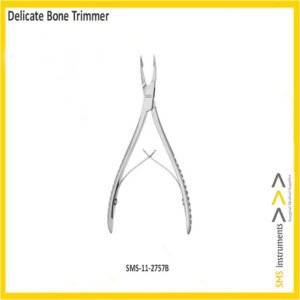Description
Bone Rongeurs
Size: 16.5 cm
2316 – (1.0 mm Inside)
2317 – (2.0 mm Inside)
2318 – (2.50 mm Inside)
Dental Instruments
| Surname | Bone Rongeur |
| Tip Configuration | Blunt |
| Size / Model / Figure | 16.5 cm |
| curvature | Angled |
| Handle | Plier With Double Spring |
| Finishing | Mirror Polish Finishing |
| Instrument Type | Dental Bone Rongeures |
| Material | Stainless Steel |
| Disposable or Reusable | Reusable |
| Rusting Prevention | Passivation Processed |
| Cleaning | Ultrasonic Cleaned |
| Sterile or Non-Sterile | Non-Sterile |
| Latex or Latex-Free | Latex-Free |
| Test Performed | Boil, Shape & Performance Test |
| Grade | Premium OR-Grade |
| Packing | Individually Packed in SMS Brand printed Poly-sleeve |
Bone Rongeures
A Dental Rongeur is heavy-duty surgical instrument with a sharp-edged, scoop-shaped tip, used for gouging out bone. Rongeur is a French word meaning rodent or ‘gnawer’. A rongeur can be used to open a window in bone, often in the skull, in order to access tissue underneath. They are used in neurosurgery, pediatric surgery, and orthopedic surgery to expose areas for operation. A rongeur is also used in oral maxillofacial surgery to remove bony fragments or soft tissue. . It is also used in hand surgery to cut traumatic amputated bone to allow skin to be closed over the defect. A rongeur can also be used in cadaver dissection lab to break through ribs when removing the anterior chest wall.
Rongeurs are surgical dental instruments used to trim, contour and remove bone after extractions. Generally rongeurs have a spring mechanism between the handles and a sharpened working end.
Rongeurs are surgical tools used for removing small pieces of bone or tough tissue. Choose from various types of high quality, stainless steel rongeurs suitable for use by nasal, plastic, or orthopedic surgeons. Rongeurs are like pliers with a heavy, pointed jaw. They are used for gnawing holes in bones during surgery. This could be neurosurgery where the surgeon must remove part of the skull to expose the brain. It could be an orthopedic surgery or even a cadaver dissection. With the rongeurs, we have bone cutters, too. These are also heavy duty instruments designed manipulating bones during small animal surgery. These instruments are for use a research laboratory.
Bone Rongeur: Clinical Tips
- Smaller amount of bone should be removed in each of multiple bites but never large amount of bone in a single bite.
- A constant cleansing of the blades is necessary.
- Rongeures are delicate and relatively expensive therefore, never remove teeth without rongeurs.








